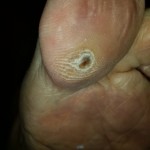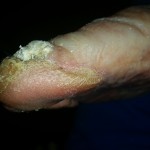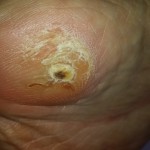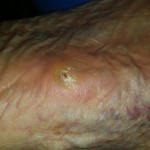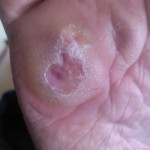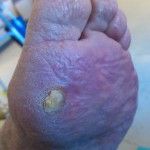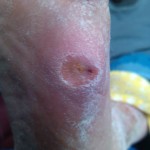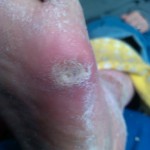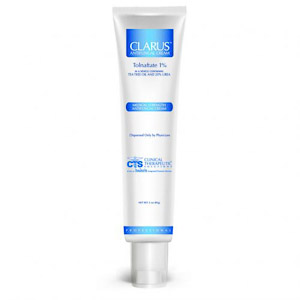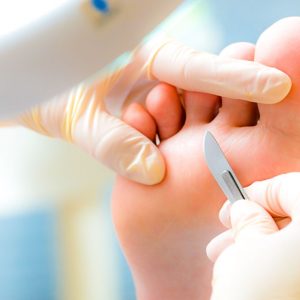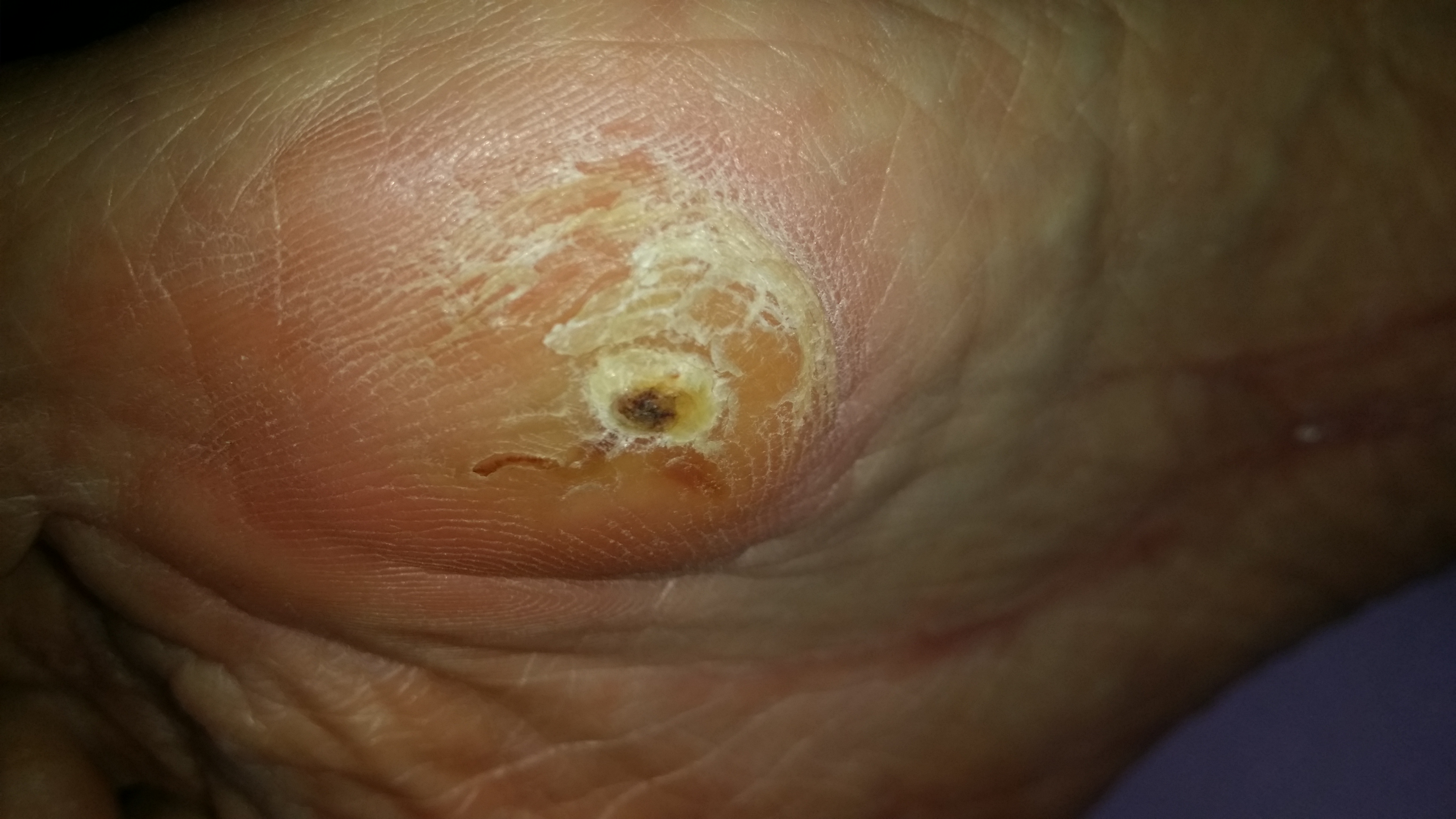
Tyloma under the 1st MTJP
Painful Calluses
Painful Calluses normally occur of area of pressure associated with prominent bones, there are 4 types commonly seen tylomas, Intractable plantar keratosis (IPK), porokeratosis, and plantar warts. Each have specific characteristics and may be difficult to distinguish. Painful calluses are created in response to pressure and/or shear force in the skin while warts are a viral infection. Calluses are created to protect the skin from breaking down and causing open wounds. Areas of high pressure and shear force (rubbing of the skin) cause the dermis to protect itself by creating more skin. There are different types of painful calluses (thickened skin) which develop on the toes and feet. Some tumors can mimic a callus, like amelanotic melanomas and can be fatal. If a lesion suddenly appears, changes by growing in size, changing in color, ulcerating, and or has borders becoming irregular, it needs to be addressed by an experienced doctor and biopsied immediately. It is important you inform your physician of any changes and take pictures so your physician has a reference point. Chances are it is nothing serious,but there are horror stories..
Tylomas
Tylomas or flat calluses are one of the most common types of calluses we see in the office. This type of callus is characterized by uniformly thickened skin over prominent bones, heel, or other pressure areas of the foot. They do not have deep cores and typically not as painful as IPK’s This type of thickened skin lesion is caused by shear force. It is common in athletes, people with large bony prominences, and over weight people. Shear force is the rubbing of skin between a bone on the inside and an object of pressure outside the skin, the skin is caught in the middle.
- Tyloma caused by excessive pressure under the great toe, this is a sign of arthritis in the 1st MTPJ
- Pinch callus under the great toe, these are common with arthritis of the 1st MTPJ
- Tyloma under the 1st MTJP
- Tyloma under the navicular tuberosity due to a collapsed arch
Tyloma Treatment
Tylomas can become thick dry and crack if left untreated for extended periods. Conservative treatment of tylomas includes offloading pressure, exfoliating creams, properly fit shoes, cushioning, orthotics, and in some cases shoe modifications. Many times a combination of these techniques are indicated. Surgical treatment of tylomas, is centered around reducing pressure and varies with the cause.
Intractable Plantar Keratosis (IPK)
- IPK with deep core
- Painful IPK under the 1st toe joint
- Debrided IPK, notice the black dots and deeper clear areas the “core”
- IPK before debridement, the appearance is very similar to a Tyloma
Intractable plantar keratosis or IPK’s are usually much more painful calluses though similar in superficial appearance. Intractable plantar keratosis are caused by pressure and shear force rather than shear force alone. IPK’s have a deep core present which becomes visible when they are debrided (trimmed). The core usually communicates with a sharp bony projection or focalized pressure area. The bony projections can be caused by arthritis, lack of a fat pad on the foot, or a fracture that did not heel properly. These types of skin lesions are extremely painful to walk on, patients commonly say it feels like there’s a pebble in their shoe.
Intractable Plantar Keratosis (IPK) Treatment
Conservative treatment of IPK’s consists of debridement (trimming) the thickened skin and removing the core, offloading, cushioning, orthotics, and shoe modifications. IPK’s are very difficult to debride correctly, because the core must be removed in order to achieve relief. Offloading, cushioning, orthotics, and shoe modifications are often done as well, but the location and bones involved often dictate the preferred modalities. Surgical Treatment for IPK’s is much like the surgical treatment of tylomas and focuses on reducing projections of bone.
Porokeratosis
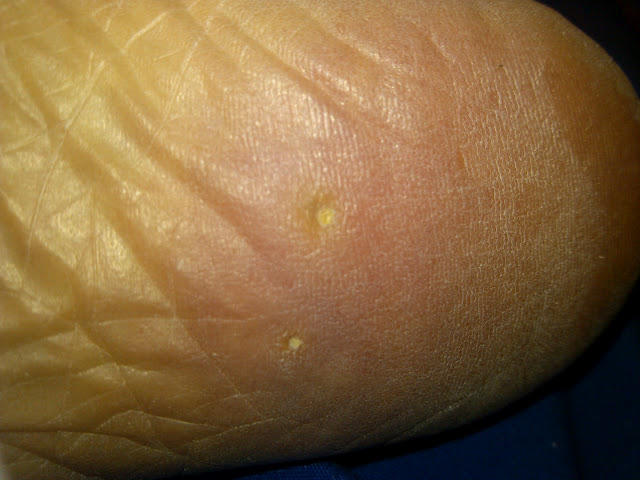
Porokeratosis
Porokeratosis are very similar to intractable plantar keratosis, however, the cause of porokeratosis has yet to be determined. Porokeratosis are not associated with any particular type bony prominence, structural problem in the foot, or virus. They look much like IPK’s but they can occur anywhere on the bottom of the foot. There is a deep core with thickened skin surrounding the core, and no black dot present as there is in plantar warts. Some doctors believe porokeratosis are related to foreign bodies that have penetrated into the dermis, causing the skin to produce a protective deposit of skin. Porokeratosis can appear as a single lesion or multiple lesions over any part of the bottom or plantar surface of the feet . People describe the discomfort as if there were several pebbles stuck to the bottom of their foot or in their shoe.
Porokeratosis Treatment
Porokeratosis can become very painful over time depending on the location. Several different treatments have been attempted over the years including injections into the base of the lesions with dehydrogenated alcohol, debridements, and exfoliating agents. Debridement can be painful, but often gives immediate relief when done correctly. In order to debride porokeratosis correctly, it is important the core of the lesion is removed. Using a pumice stone or other abrasive material only removes the outer surface not the core. Minimal relief is achieved from this type of debridement.
For information on Plantar Warts check out the Plantar Wart’s Page

